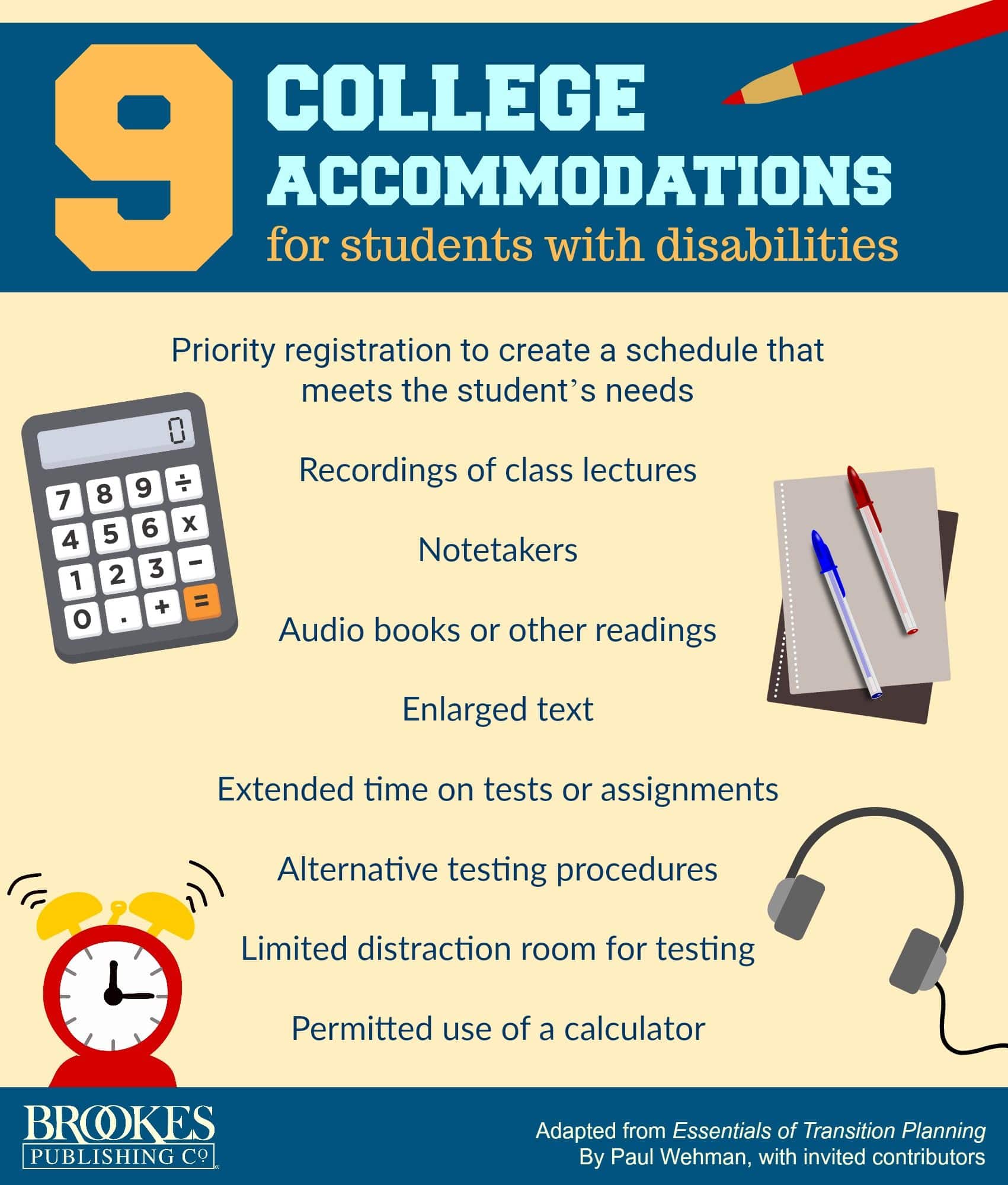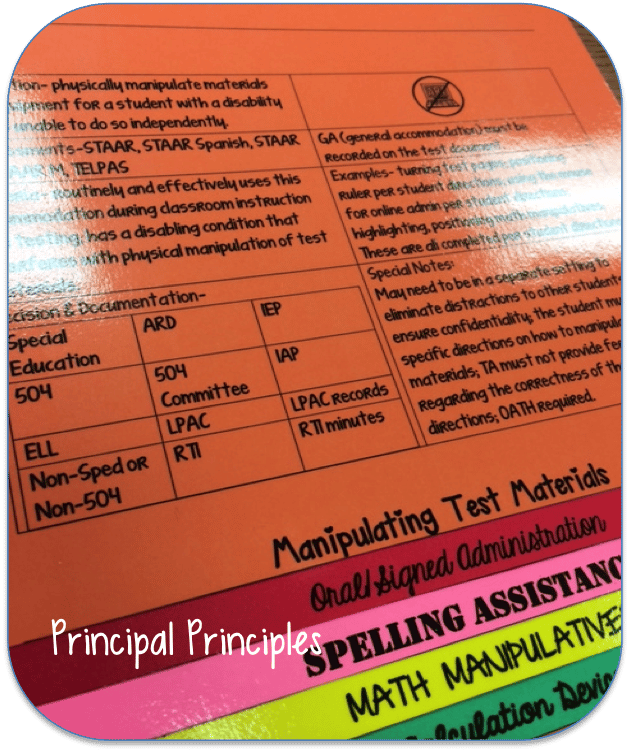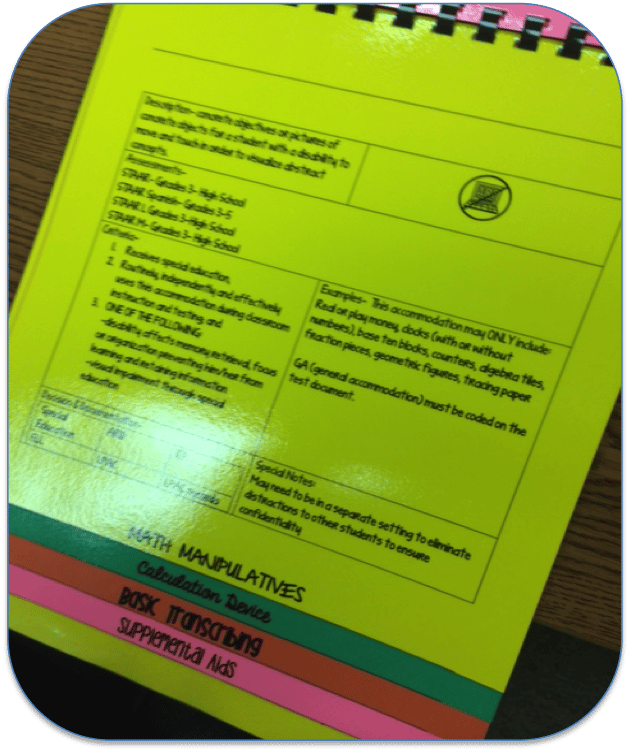Response Accommodations Answer What
These are the different ways you allow students to demonstrate their understanding of the material. Response accommodations focus on the assessment of student learning and also answer what students will be asked to provide as evidence.
Examples include:
- the use of graphic organizers or concept maps
- multiple formats for showing learning
- multiple-choice questions instead of open-ended questions
- oral responses or a scribe for those who struggle with writing
- option to type any written work or record themselves answering
Hopefully, this gives you a little better understanding of what types of accommodations you might consider using or are already including in your math lessons.
Of course, there are more examples than those I’ve listed here, but keeping these four basic types in mind can help with your planning. It is always a good idea to have a conversation with the student’s parents or teacher about their needs so you can create a plan that best meets his/her needs!
Who Is Eligible For An Accommodation
A student must meet two criteria to be eligible for an accommodation. First, the student must meet the essential or requisite eligibility requirements of the program, service or activity in which he or she wishes to participate with or without an accommodation. This means that the student must meet the requisite eligibility requirements in spite of his or her disability. Second, the student must have a documented disability as defined by the Americans with Disabilities Act or the Rehabilitation Act.
Instructional Or Presentation Accommodations Answer How
Instructional accommodations focus on how learning happens for the student. These changes to instruction are meant to provide more support for students as they learn new concepts. This can include the use of additional materials, like manipulatives, or tools to aid learning.
Examples of instructional accommodations include:
- modified or simplified language
- frequent check-ins to monitor understanding
- directions provided in multiple formats
- access to teacher or peer notes
- questions read aloud to the student
- pre-teaching vocabulary
Also Check: How Much Of My Social Security Disability Is Taxable
Sec 12212 Alternative Means Of Dispute Resolution
Where appropriate and to the extent authorized by law, the use of alternative means of dispute resolution, including settlement negotiations, conciliation, facilitation, mediation, fact-finding, minitrials, and arbitration, is encouraged to resolve disputes arising under this chapter.
Sec. 12213. Severability
Should any provision in this chapter be found to be unconstitutional by a court of law, such provision shall be severed from the remainder of the chapter, and such action shall not affect the enforceability of the remaining provisions of the chapter.
Accommodations Vs Interventions For Disadvantaged Students

When seeing the unequal rates of accommodations provided across socioeconomic classes, it may be tempting to simply provide more accommodations to less privileged students. Certainly, many students in this population need and fully deserve accommodations to access their educational programs. However, even here, accommodations are often used too readily, and with different but still quite problematic effects on educational equity.
You May Like: How To Apply For Disability In Colorado
What Testing Accommodations Are Available For Students With Disabilities
The goal of accommodations for standardized testing is to allow students or test takers with disabilities to get a score that accurately reflects the skills being tested. This means that different disabilities need different strategies to achieve this goal.
While the specific accommodations required are unique to each student with disabilities, there are some general categories of accommodations that are most frequently offered. If you’re not sure what accommodations would be best for you or your child, this list can be a good place to start.
Sec 12183 New Construction And Alterations In Public Accommodations And Commercial Facilities
Application of term
Except as provided in subsection of this section, as applied to public accommodations and commercial facilities, discrimination for purposes of section 12182 of this title includes
a failure to design and construct facilities for first occupancy later than 30 months after July 26, 1990, that are readily accessible to and usable by individuals with disabilities, except where an entity can demonstrate that it is structurally impracticable to meet the requirements of such subsection in accordance with standards set forth or incorporated by reference in regulations issued under this subchapter and
Elevator
Subsection shall not be construed to require the installation of an elevator for facilities that are less than three stories or have less than 3,000 square feet per story unless the building is a shopping center, a shopping mall, or the professional office of a health care provider or unless the Attorney General determines that a particular category of such facilities requires the installation of elevators based on the usage of such facilities.
Recommended Reading: Do Spouses Of 100 Disabled Veterans Get Benefits After Death
Temporary Injuries Or Conditions
The CSD may also assist students who have a temporary injury or condition, which results in a functional limitation. Examples may include broken bones and pregnancy. Assistance is determined on a class-by-class basis and is dependent upon the nature of each course and the method of instruction as it relates to the studentâs functional limitations. Accommodations are extended to students with temporary conditions for the duration of their functional limitations associated with the condition.
Temporary accommodations may include, but are not limited to:
- Notetaking assistance if the student is unable to write
- A scribe for assessments if the student is unable to write
- Assistance with taking exams and/or quizzes if the student is unable to write
- Referral to the Accessible Van Service to assist with on-campus transportation
- Referral for personal assistants
- Referral to campus and/or community resources.
Since temporary conditions can occur at any point during the semester, the timing can significantly impact the accommodation options available to the student. Timely and open communication with the CSD, faculty and other campus offices, as needed, about the nature and duration of the condition and requested assistance can often result in satisfactory solutions to the short-term issues caused by the injury or condition. Students with temporary injuries or conditions are encouraged to contact the CSD to determine accommodation options.
List Of Accommodations For Students With Disabilities In College
With proof of eligibility, students may be entitled for for a number of classroom accommodations when they transition to college, including:
- Audio-recorded texts of course materials
- Sign language or other effective methods of making lectures or orally recited materials available to those who are deaf or hard of hearing
- Classroom equipment that is adapted for use by students with manual impairments
- Physical facility modifications that can include ramps, curb cuts into the sidewalk, and hand controls
- Interpreters, readers, note takers, computer assisted transcription, listening devices, and telecommunication
- Additional time to complete tests, coursework, and graduation requirements
- Replacement of non-essential courses towards degree requirements
To further understand which accommodations you qualify for, its best to speak directly with the disability resource center on your campus.
You May Like: Can You Get Welfare While Waiting For Disability
Instructional Practices Often Confused With Accommodations
Teachers use a number of instructional practices to improve their students learning. It is not unusual for several of thesespecifically, modifications, instructional strategies, and interventionsto be confused with accommodations. In the sections below, well describe each of these practices and explain what makes them different from accommodations.
Modifications
Modifications are adaptations that change what students learn and are used with students who require more support or adjustments than accommodations can provide. Whereas accommodations level the playing field, modifications change the playing field. Unlike accommodations, modifications:
- Do change the expectations for learning
- Do reduce the requirements of the task
The table below lists some modifications that could address the barriers presented by students disabilities. Note that the modifications actually change or modify the expectations or requirements of the task.
| Disability category |
Assistance With Reading And Seeing
There are several options for test-takers who are blind or have difficulty seeing or reading, such as:
- Drawings or diagrams with raised lines
- Recorded audio versions of the test
- Text to speech technology
- A person to read the test live
With tests that are administered digitally, like the LSAT, some of these options, like large print and text to speech, are available automatically without requesting an accommodation. You won’t usually be able to get multiple accommodations for the same disability, so you’ll need to pick one of these.
You May Like: Is Disability Income Taxable By Irs
Sec 12204 Regulations By Architectural And Transportation Barriers Compliance Board
Issuance of guidelines
Not later than 9 months after July 26, 1990, the Architectural and Transportation Barriers Compliance Board shall issue minimum guidelines that shall supplement the existing Minimum Guidelines and Requirements for Accessible Design for purposes of subchapters II and III of this chapter.
Contents of guidelines
The supplemental guidelines issued under subsection of this section shall establish additional requirements, consistent with this chapter, to ensure that buildings, facilities, rail passenger cars, and vehicles are accessible, in terms of architecture and design, transportation, and communication, to individuals with disabilities.
Qualified historic properties
In general
The supplemental guidelines issued under subsection of this section shall include procedures and requirements for alterations that will threaten or destroy the historic significance of qualified historic buildings and facilities as defined in 4.1.7 of the Uniform Federal Accessibility Standards.
Sites eligible for listing in National Register
With respect to alterations of buildings or facilities that are eligible for listing in the National Register of Historic Places under the National Historic Preservation Act , the guidelines described in paragraph shall, at a minimum, maintain the procedures and requirements established in 4.1.7 and of the Uniform Federal Accessibility Standards.
Other sites
Who Can Have Accommodations & Modifications In School

Students who are determined to have a disability under the Individuals with Disabilities Education Act can get accommodations and medications.
Students who have a disabling condition diagnosed by a medical professional can also access accommodations/modifications.
Students eligible for accommodations and/or modifications in school have an Individualized Education Program or a 504 Plan .
These are legal documents that outline the accommodations and modifications, along with other relevant information about the students needs.
You may be interested in 33 Possible Accommodations and Modifications in the Virtual Setting
Read Also: How Much Disability Do You Get For Ptsd
Different Types Of Supports
Special Education
By definition, special education is specially designed instruction . And IDEA defines that term as follows:
Specially designed instruction means adapting, as appropriate to the needs of an eligible child under this part, the content, methodology, or delivery of instruction To address the unique needs of the child that result from the childs disability and To ensure access of the child to the general curriculum, so that the child can meet the educational standards within the jurisdiction of the public agency that apply to all children.
Thus, special education involves adapting the content, methodology, or delivery of instruction. In fact, the special education field can take pride in the knowledge base and expertise its developed in the past 30-plus years of individualizing instruction to meet the needs of students with disabilities. Its a pleasure to share some of that knowledge with you now.
Adapting Instruction
Sometimes a student may need to have changes made in class work or routines because of his or her disability. Modifications can be made to:
- whata child is taught, and/or
- howa child works at school.
For example:
Jack is an 8th grade student who has learning disabilities in reading and writing. He is in a regular 8th grade class that is team-taught by a general education teacher and a special education teacher. Modifications and accommodations provided for Jacks daily school routine include the following:
Setting. For example,
How Donotpay Can Help
Applying for accommodations for students with special needs can be a complicated process. DoNotPay, however, makes this whole process very easy.
DoNotPay will help you get testing accommodations in 3 easy steps:
And that’s it! DoNotPay will write a letter to the company administering your exam laying out the case for your accommodation request both concerning that company’s internal policies and relevant disability law. You should receive a response soon.
You May Like: Va Disability Secondary To Ptsd
For Learning Disabilities And Attention Deficit Hyperactivity Disorder
- Seating location
- Use of a notetaker or tape recorder
- Extended test time
- Alternative location for a test
- Use of memory aids such as a calculator, thesaurus, spell checker, or formula cards. Directions and deadlines given both orally and in writing
- Use of visual aids when possible
- Use of a word processor to take a test. Student may utilize: Kurzweil 1000 and 3000, IBM Via Voice, Dragon Naturally Speaking
- Reduce the writing load through the use of handouts, supplementary texts, etc.
Introduction To The Americans With Disabilities Act
The Americans with Disabilities Act , landmark civil rights legislation, was enacted in 1990. ADAs purpose is to ensure that people with disabilities are granted equal access to employment, public services, places of public accommodation, transportation, and telecommunications.
Title II of the Americans with Disabilities Act prohibits discrimination against people with disabilities by public entities. These provisions include publicly funded educational institutions such as universities, colleges, and technical schools. Privately funded educational institutions are subject to similar non-discrimination requirements under Title III of the Act and employers are covered under Title I.
The prohibition against discrimination is very broad and encompasses all the programs, activities, and services that your institution provides. In general the Act requires that people with disabilities have an equal opportunity to benefit from or participate in your services.
A major thrust of the ADA is to ensure that people with disabilities gain access to the mainstream of American society. Access to education is one key to opening the doors of mainstream society to people with disabilities.
Don’t Miss: How To Apply For Temporary State Disability In California
Scenario : My Student Understands The Concepts But She Struggles To Finish Assignments Because She Is Pulled From Class Often Or Works Slowly
This is a common issue that is often mentioned when considering how to meet the needs of struggling learners or those that receive services outside the classroom. Therefore, here are five accommodations you may consider when you’ve got a student in this situation:
Typical Accommodations For Students With Disabilities
Flexibility and effective communication between student and instructor is key in approaching accommodations. Although students with similar disabilities may require different accommodations, it is helpful to be aware of typical strategies for working with students who have various types of impairments.
Read Also: Is Social Security Disability Income Taxable By The Irs
What Are Testing Accommodations
Testing accommodations are changes to the regular testing environment and auxiliary aids and services2 that allow individuals with disabilities to demonstrate their true aptitude or achievement level on standardized exams or other high-stakes tests.
Examples of the wide range of testing accommodations that may be required include:
- Braille or large-print exam booklets
- Screen reading technology
- Scribes to transfer answers to Scantron bubble sheets or record dictated notes and essays
- Distraction-free rooms
- Physical prompts and
- Permission to bring and take medications during the exam .
What Is A Disability Under The Ada

Disability is defined as any physical or mental impairment that substantially limits one or more major life activities such as caring for oneself, performing manual tasks, walking, seeing, hearing, speaking, breathing, learning, or working. Substantially limited generally means that a person is unable to perform a major life activity that the average person in the general population can perform. Mitigating or corrective measures such as medication, or corrective lenses may be considered when determining whether a person is substantially limited.
The ADA also prohibits discrimination against individuals who have a record or history of being substantially impaired and individuals who are regarded as having such impairments..
At each college a designated staff decides whether a student meets the definition of disability under the ADA requires. Persons are not entitled to protection of the ADA simply because they have been diagnosed with a disability. The disability must substantially limit their ability to perform major life activities. Thus, this disability determination process is on a case-by-case basis. A college cannot set-up predetermined categories of what types of disabilities will be accommodated and what types will not.
To help you understand the potential scope of covered disabilities a non-exhaustive list of types of conditions that may be covered by the ADA includes:
Recommended Reading: Library Of Congress Veterans History Project
Food During Class And Exams
Allowing the student to consume their own food and/or drinks in the classroom provides the ability to manage a variety of health conditions that are affected by diet. The student is expected to be discreet if they need to use this accommodation during lecture. If access to food and/or drink in the classroom/lab could be problematic, faculty are asked to please contact SDS.
Americans With Disabilities Act Of 1990 As Amended
Editors Note:
Here is the text of the Americans with Disabilities Act of 1990 , including changes made by the ADA Amendments Act of 2008. Congress passed the ADA as a Public Law, and it originally was in a different format than presented here. To make the law more widely available, the ADA was later reformatted and published in volume 42 of the United States Code. One small part of the ADA is found in title 47 of the United States Code. The text below mirrors the law as it is found in the U.S. Code. Because the numbering system is different in the U.S. Code, the headings provide in brackets the title numbers of the ADA as originally enacted.
Also Check: How To File For Permanent Disability
